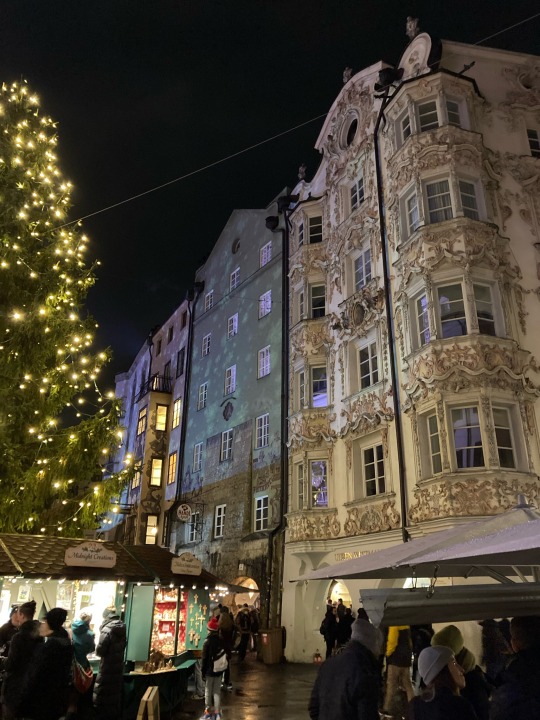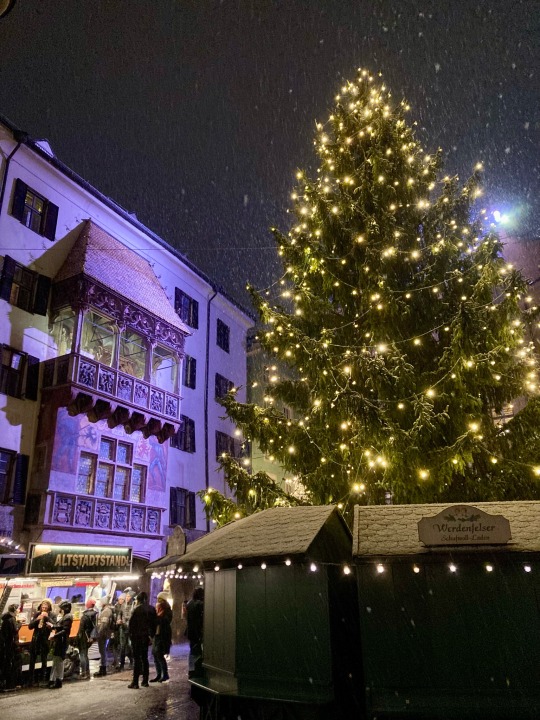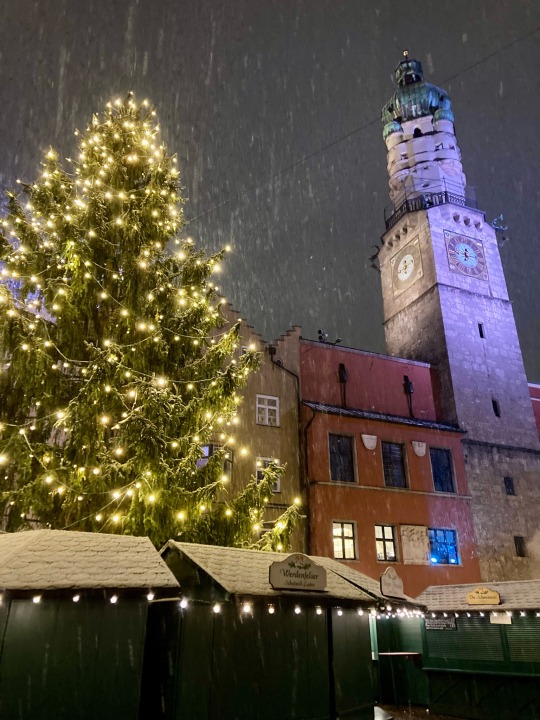#christkindl
Text
I was trying to look around to see if I could find some more information about Père Noël in its pre-Americanized incarnation online, but unfortunately most websites share the misinformation that "Père Noël" only existed from the 50s onward and was a French invention... No. [Note: I know books exist folks, but I precisely wanted to do a web research first]

There is only one website that does not share this idea and does identify Père Noël as a typical French figure that was then overtaken by the American Santa Claus, and the most fascinating thing is that it points out (despite previous sources I shared claiming "Père Noël" was first recorded in literature in the mid-19th century, by people describing their youth around the turn of the 18th-19th century) that Père Noël seems to have existed since the Middle-Ages, with texts referring to "Père Noël" or to "Monseigneur Noël". But it does recognize that the Père Noël traditions really boomed in the 19th century and were associated with the bourgeoisie of the time...
The website in question however is mostly focused on the various local, regional incarnations of the gift-giver - because as with many things in France, this tradition is rather a set of various regional and localized specificities that were ultimately synthetized into one entity.
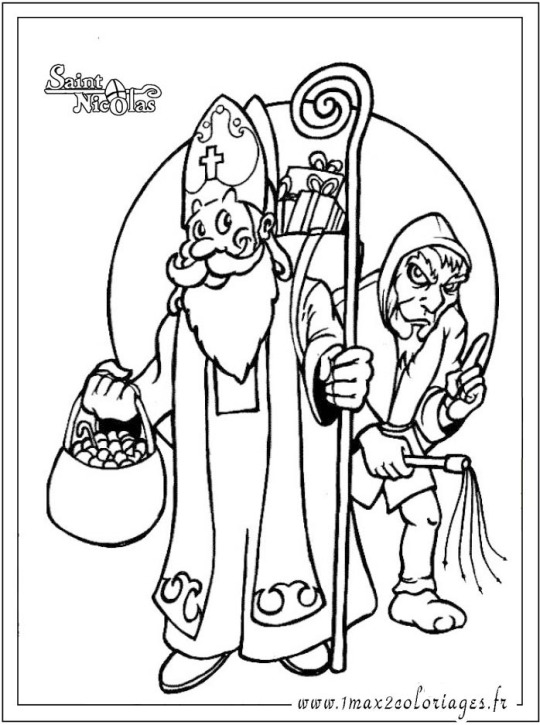


It reminds that in the Lorraine and Alsace region, the Germanic cultures and German influences make it so that Saint Nicholas and Christkindl are still the main gift-givers. In Lorraine it is Saint Nicolas who is most honored (he is after all the saint patron of Lorraine). Appearing in his bishop outfit that makes him look a lot like Santa Claus (thick white beard, large clothes of red and white), every 6th of December he brings gifts and treats to nice children - while naughty children are confronted by his dreaded companion, Père Fouettard dressed in blacks, who beats up with a stick bad children. Saint Nicolas is also still strongly celebrated in the North of France (aka, what is above the Parisian region, because despite what some foreigners believe, Paris is not part of the North).

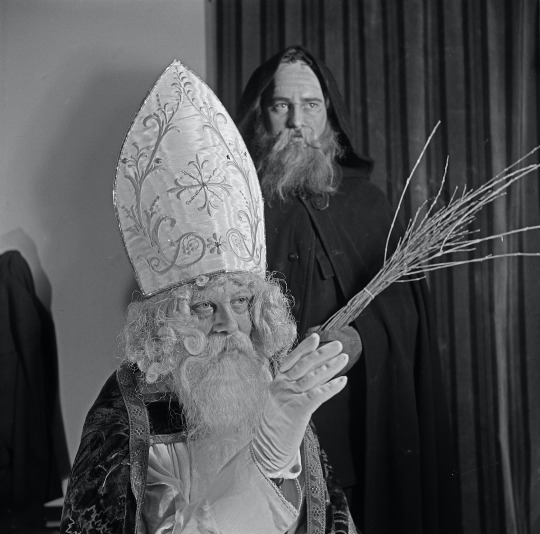
While in Alsace it is the Christkindl that still goes strongly, with Hans Trapp as its own Père Fouettard. The website briefly reminds that Christkindl is an avatar/incarnation of the Child-Christ, or Baby Jesus, that ended up being fused with the 23rd of December Saint, Sainte Lucie (Saint Lucia), resulting in this unique Christmas figure appearing as a woman dressed in white with a crown made of fir branches topped by four candles. It also reminds how Christkindl stays a symbol of Protestant end-of-the-year celebrations, as they pushed the Christkindl figure to oppose and replaced the Catholic celebrations of Saint Nicolas. Finally, there is an Alsace-specific legend that claims Hans Trapp actually originated as an Alsacian lord that tyrannized his people - Hans von Trotha, the 15th century lord of Wissembourg.
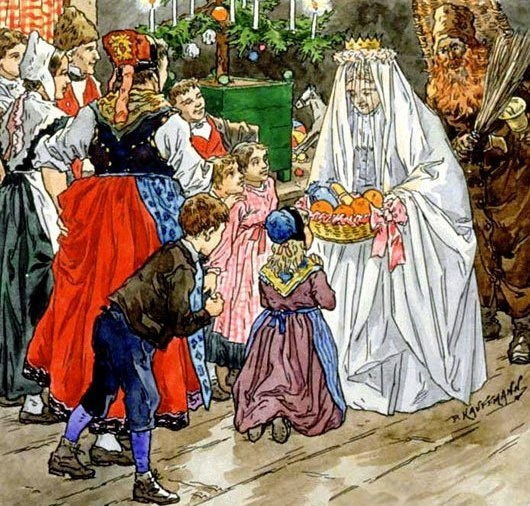

[Given the Alsace region has a lot of website pages about its traditions I'll place here in brackets informations from other websites:
The Christkindl, also written Christkindel or Chriskindla, is a Christian figure that is supposed to be an embodiment of L'Enfant Jésus, Child Jésus (the name comes from Christ-Kindel ; Christus-Kindlein, Christus als Kind), but definitively was influenced by Saint Lucia, who is very big in Scandinavia. In fact, Saint Lucia and the Christkindl look a lot like each other - female entities dressed in white with a crown of candles... Though the Christkindl can appear both as an adult woman and as a little girl, and also tends to have white veils. People tend to also find in Christkindl remnants of the Germanic goddess Berchta. No need to tell you that the Christkindl is big in all parts of the world influenced by German culture - Germany, Austria, northern Italy, Croatia, Slovenia, Switzerland, Czech Republic, and even some parts of Brazil, the ones where there was strong German imigration.
The Christkindl appeared in the 16th century with the Protestant Reform. Up until this point the day of Saint Nicolas was a very big thing in Alsace - saint-patron of school students, he offered good children mandarines and "manala" (a brioche in shape of a child). But the Protestants did not agree with this (Protestants were known to strongly dislike saints in general), and so they replaced the saint with the Christic figure of Christkindl, while keeping Père Fouettard/Hans Trapp (whose job was to threaten with stern lectures naughty children... or take them in a bag to abandon them in the deep dark woods). The change occured over the 16th century, from 1530-1536 (last mentions of Saint Nicolas in Alsace) to 1570 (first mention of Christkindl, when the Klausemärik was replaced by Christkindelmärk). In fact, Christkindl still has some Saint Nicolas traits - she also goes around with a donkey, named Peckeresel, which carries two bags, one for the treats (mandarines and bredalas), one for the whips. People left hay or carrots for the donkey to eat by the front door. Pastor Johannes Flinner made a strong public attack against saint Nicolas in Strasbourg during the "cultural transition", by pointing out that distributing gifts to all should be the prerogative of the Christ and no one else.
During the 20th century the Christkindl lost popularity in Alsace (jee, I wonder why France would like to bury Germanic traditions in the century of World War II) - but it returned in the traditions from the 1990s onward.
Fascinatingly, despite being supposedly a Christ-figure of an angel, the Christkindl, or White Lady, is also frequently called in alsace, a "fée", a fairy, la fée de Noël, the Christmas fairy. It doesn't help that she sometimes carry around a wand with a star at the tip, that is strikingly reminding of the stereotypical fairy-wand. Another irony of fate - despite the Christkindl being brought over to replace Saint Nicolas, the two currently still coexist in Alsace thanks to people not wanting to abandon the good old bishop. A third fun fact: originally the Christkindl could be played as much by women as by men, due to being a truly androgynous entity. From the 16th century onward, the Saint Nicolas celebrations were replaced in Alsace by parades of teenagers of both sexes dressed in white, going from door to door to give gifts and sing Christmas songs. However you can't have teenage boys and girls go around late at night without getting some problems... And those "Saint Nicolas hook-ups" were a real problem in Alsace, you have records from the 17th and 18th centuries pointing out how authorities have to try to refrain all the Christkindl from... well you know.]
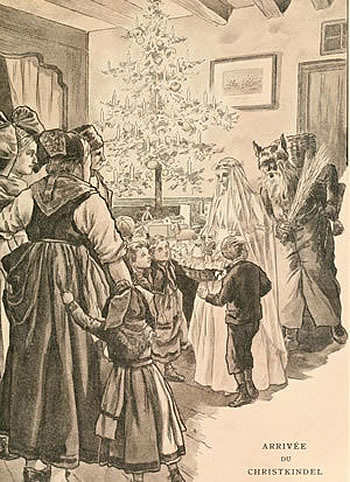


The next entity presented is the famous Pays Basque character of Olentzero, whose appearance is that of a coal-man. Well a bizarre coal man - he has a bag filled with coal in one hand, a sickle in the other, a large beard on his face and a béret on his head. According to the Basque-version of the Nativity lore, he lived at the top of the mountains but saw in the sky the announcement of the birth of Kixmi (Basque name for Jésus), and he descended from his mountains to announce the good news. While he is the gift-giver of Pays Basque, leaving gifts for children in the night between the 24th and 25th of December, entering in the house by the chimney ; he is also a bogeyman figure, as he was a scary-looking man who was said to take away in a bag naughty children. As with everything Basque, Olentzero is actually a pre-Christian figure, as the very name of the character is related to the "pagan" winter solstice celebrations of the old Basque religion.
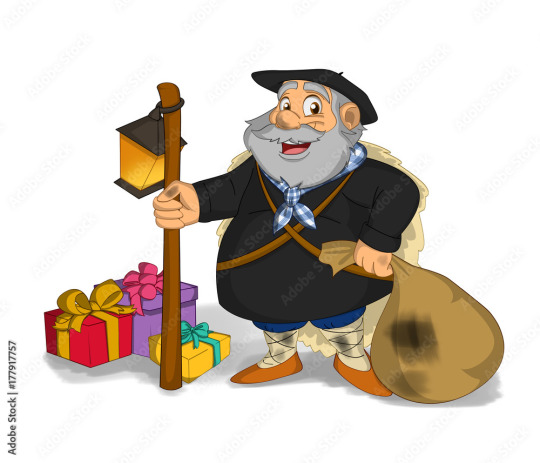
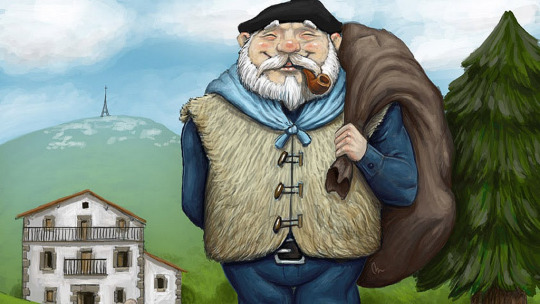
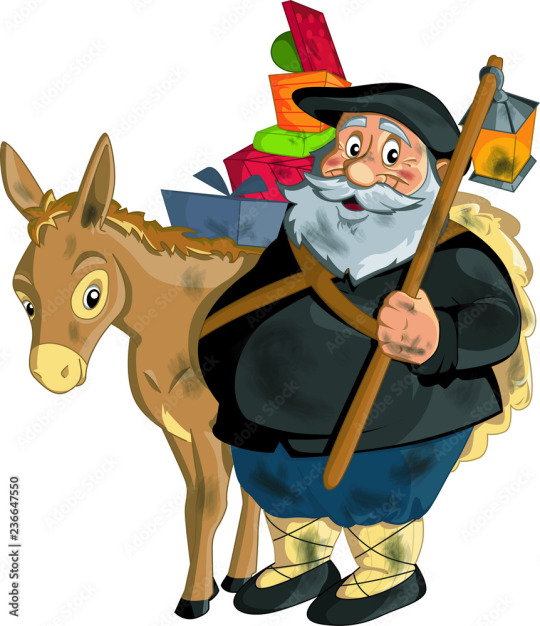
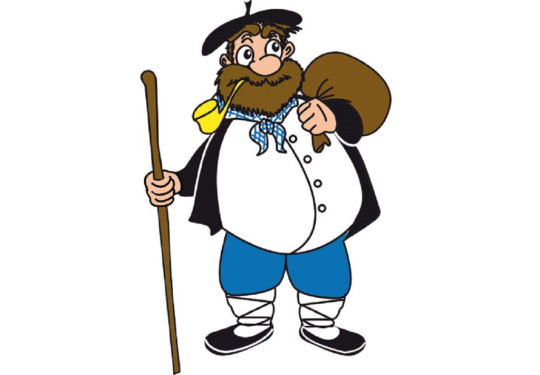
[Again, time to bring some more information from other websites to make sure I give a more complete portrait:
Long story short, because the Basque folklore is very well documented and I can't spend too much time on this, the Olentzero (or Olentzaro, Orentzaro, Omentzaro, Orantzaro...) is at the same time the Basque name for Christmas and the Basque figure of the coal-man that brings gifts during Christmas. He is supposed to be a grotesque character - rude, fat, dirty, gluttonous, his face blackened by soot, with worn-out clothes... He is basically a caricature of mountain-men and forest-men. Sometimes he is even given monstrous traits such as "having as many eyes as there are days in the year, plus one" - which is reminding of a French being of the New Year folklore called L'Homme aux Nez who also has as many noses as there are days in the year...He typically holds branches of gorse in one hand and a sickle in the other.
He comes down from the mountains, enters houses by chimneys, goes into the kitchen once everybody goes to sleep to eat all leftover food, and he warms himself by the fire - either you had to leave a log burning just for him, either he used the flames of the fire to burn his gorse branches. In fact, "olentzero" was also the name of a special log that was left bruning in the fireplace from Christmas to the 1st or 6th of January. This theme of the "coal man" of winter or the burning of branches all answers to a deep motif of bringing back light and heat in the heart of the cold and the dark. Him holding a sickle has made people draw parallel between him and the figure of Saturn/Kronos.
In fact, there is an old tradition, long before the Olentzero was embodied by a disguised man or by a mannequin paraded through the villages, to embody the character simply by the sickle. The sickle hanged by the chimney, as a threat to all disobedient children, to all lying children, and to all children that refused to go to bed. Another symbol of the Olentzero, outside of the sickle and the coal-sack, is a wine-bag or wine-bottle that he carries around, because to add to the grotesque he is also a drunkard, and according to stories it is because he gets often drunk that his wife regularly beats him. (Because yes the Olentzero has a wife, a character named Mari Domingi and who is typically depicted wearing a medieval regional outfit). However it seems that all this grotesqueness is simply due to the Olentzero being a character from the old Basque mythology that got Christianized - think of how the Dagda of Celtic mythology also got more buffoonish/clownesque/grotesque as time passed. We do know that the roots and origins of the character lie in the valley of Bidassoa...)
Today gone is the creepy bogeyman and grotesque glutton ; the Olentzero has evolved into a kinder, nicer, cleaner incarnation that is closer to the Père Noël traditions. For example he now parades through streets during the day, riding a horse (pottok) or by foot, giving children candies and sweets (including fake-coal actually made of sugar) ; and the legend claims he goes down from the mountain to offer coal and wood-logs to the poor families that can't afford fuel for their fire]


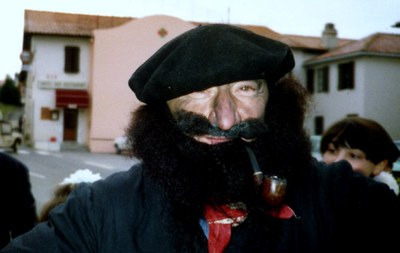

And finally, we find back our good old Père Janvier! Here we have most of the same info as previous. Père Janvier was a Bourgogne character, most present in the Morvan and Nivernais regions up until the 1930s. He brings gifts in the night between the 31st of December and the 1st of January by going through the chimney - chimney which must be decorated with holy and mistletoe. Père Janvier (Father January) typically looks like a skinny old man with a long white beard, dressed in a brown monk-like robe, and he is usually bent due to wearing on his back a heavy wicker basket filled with toys. And he too has for companion the Père Fouettard.
Most interestingly, the website mentions "Père Janvier variations" across France, most notably the Savoie character of Père Chalande, and the Normandie character of Barbassioné.


More information from other website. Le Père Chalande (or Papa Chalande, Daddy Chalande) was indeed a figure of the Savoie region, but also of the Dauphiné, and he was also present in Geneva. Martyne Perrot, in her book "Faut-il croire au Père Noël? Idées reçues sur Noël" even lists the area of action of this figure as: Savoie, Suisse romande, Bresse, Forez, Ardèche, Gard, Lozère and Hérault. He is basically identical to Père Noël because "Chalande" is just an old word for "Noël" (Christmas) in the regional language known as arpitan.
There was a traditional song that went as such: Chalande est venu / Son chapeau pointu / Sa barbe de paille / Cassons les anailles (noisettes) / Mangeons du pain blanc / Jusqu’à Nouvel An. / Il monte dans sa chambre / Il trouve une orange / Il la pluche / Il la mange / On l’appelle le petit gourmand. / Il descend les escaliers / Il se casse le bout du nez / Il va chez le cordonnier / Se faire mettre une pièce au nez / Quand il est malade / Il mange de la salade / Quand il est guéri / Il mange des souris/ Toutes pourries !
I can't translate the full song, but it refers to various traditions. For example leaving an orange for Père Chalande ; Père Chalande wearing a "beard of straw and a pointy hat" (leftovers of Saint Nicolas, especially the pointy hat) ; Père Chalande giving "anailles" (walnuts) to children ; and the habit of placing inside the Christmas log (real log of the fire) chestnuts, so that the burning of the Christmas log doubled as the cooking of the wintery treats. Raymond Christinger wrote in 1965, in a set of research about Geneva folklore, an article studying the character of Chalande, if you know how to read French: here.
While doing Chalande research I stumbled upon a Swiss theory brought forward by a journalist named Bernard Léchot - I don't know how accurate this is when it comes to actual evolution of Christmas figures, but here it is. According to him, the Christmas archetype of the "Old Man" actually comes 18th century Germany. In this era of rationalism, the German Protestant landgraves decided to introduce some laicity to their country, and so cut-off all characters close to Christianity from their Christmas celebrations (from Saint Nicholas to Christkindl). As a result, pagan figures returned, including the Old Man in the shape of Weihnachtsmann. Which then spread to other European countries, each land creating its variation: Bonhomme Noël in France, Father Christmas in England, Père Chalande in Savoie.
As for the Barbassioné of Normandie, I found nothing about him. As in every says it is the Normandie name of Père Noël, but he doesn't have any specific thing to his character.

To conclude, I will link you to a page documenting a Père Noël/Christmas beings exposition that collected various visuals of the history of the Christmas gift-givers through time, right here.
And through it you will see the evolution from the "Scandinavian ancestors" (Thor and Odin) and Saint Nicolas (celebrated in Germanic countries and the Alsace region), to the American Santa Claus and the British "Old Father Christmas", passing by the Germanic Knecht Ruprecht, the also Germanic Weihnachtsmann, the Christinkindel (of Germany, Belgium and Alsace), the Jultomte of Sweden, and the Enfant Jésus/Child-Jesus of France and Italy...
Without forgetting the French Bonhomme Noël, the Italian Befana, the regional ancestors of Père Noël (Tante Arie, Père Chalande, or the Breton Ted Nedelec), the Russian Ded Moroz, and Mère Noël (Mother Christmas)... With additional sections about Santa Claus in advertisements, the theme of "outlaw Father Christmas", Père Noël during the World Wars, and more...
#french folklore#father christmas#père noël#saint nicolas#christkindl#père chalande#père janvier#christmas folklore#olentzero#basque folklore#hans trapp#père fouettard#christmas art#santa claus#christmas
17 notes
·
View notes
Photo

Companions of Christmas #6: Christkindl!
Martin Luther, an opponent of saint veneration, wanted to ban St. Nick from entering protestant Europe in the 16th century, but knew that many of the people still wanted him to come, and that partisans might help smuggle the jolly old man across the borders. Luther reckoned that if somebody else was giving gifts in December, people would turn their backs on St. Nick, so he prayed that God would send baby Jesus to deliver presents.
God thought, "Well, Jesus isn't a baby anymore, but I'll see what I can do." So He sent down one of His littlest angels (and heaven’s biggest St. Nick fan) to deliver presents when kids weren't looking. But since she only comes around when eyes aren't on her, Luther had no way of knowing that she wasn't baby Jesus, and he told everyone that she was. Thus, everyone started calling the angel "Christkindl" which means "Christ Child," and she delivered presents in areas where Santa (at least for a while) wasn't welcome.
Eventually, the two became work friends and they sometimes team up, especially for parades and Christkindl Markets, where holiday crafts and treats are sold.
Fun aside: Christkindl would go back to heaven in the non-holiday months and report on her progress, and Jesus thought it sounded like so much fun that he sometimes morphs into his baby form and delivers presents, too, so in some regions ACTUAL baby Jesus is the giftgiver.
#Christmas#Christkindl#Christkindl Market#Santa Claus#santa#St Nick#St Nicolas#Saint Nicolas#Christmas Art#Christkindl Art#Holiday Art
83 notes
·
View notes
Video
youtube
Denver Christkindlmarket
5 notes
·
View notes
Text

19 notes
·
View notes
Text

Christmas in Vienna,Austria with Christkindl Express
0 notes
Text
Christmas Lights & Markets: A List of Exciting Events to Keep in Mind During the Christmas Festivities in Atlanta, GA

The Lighting at Colony Square
The lighting at Colony Square in Atlanta is a spectacle that transcends traditional holiday illumination. More than just a display of twinkling lights, it's a captivating and immersive experience that transforms the heart of the city into a radiant wonderland.
At the core of this spectacle lies an artistic fusion of technology and creativity. The architectural nuances of Colony Square serve as a canvas for a dazzling array of lights that dance harmoniously in sync with music, adding a symphony of colors and rhythms to the cityscape. From vibrant patterns to graceful movements, the lighting installation embraces innovation while retaining a touch of classic elegance.
But it's not just about the visuals—the lighting at Colony Square evokes emotions and ignites a sense of wonder. As the sun dips below the horizon, the ambiance shifts, drawing locals and visitors alike into a mesmerizing world of brilliance. Families gather to marvel at the spectacle, friends reunite under the luminous canopy, and couples stroll through the illuminated pathways, enveloped in the magic of the moment.
What sets this lighting display apart is its immersive nature. It's not just an observation; it's an interactive experience. Visitors are invited to engage with the lights, whether through interactive installations, light shows, or dynamic displays that respond to their presence, creating an unforgettable and participatory experience for all.
Lighting At Colony Square 2023 will be taking place on December 01 from 5:00p onwards.
Atlanta Christkindl Market
The Atlanta Christkindl Market, nestled in the heart of the city, emerges each year as a delightful and vibrant embodiment of traditional German holiday spirit. This charming market brings a slice of Bavaria to Atlanta, inviting locals and tourists to experience the enchantment of a European-style Christmas market.
Set against the backdrop of the cityscape, the market dazzles with its twinkling lights, cozy wooden stalls adorned with festive decorations, and the warm aroma of traditional German treats wafting through the air. Visitors are transported into a winter wonderland, where they can indulge in delightful culinary experiences like sizzling bratwurst, gingerbread cookies, mulled wine, and other delectable German specialties.
But it's not just about the culinary delights—the Atlanta Christkindl Market is a treasure trove for unique gifts and crafts. From handcrafted ornaments to intricate wooden toys, the market offers an array of authentic and artisanal goods perfect for holiday shopping.
What makes this market exceptional is the lively ambiance. Visitors are serenaded by live music, festive performances, and the cheerful laughter of families enjoying the merry-go-round and other traditional attractions. But above all, the Christkindl Market captures the true essence of the holiday season—a sense of togetherness and joy. It's a place where people gather, creating cherished memories while embracing the rich cultural traditions of Germany.
Atlanta Christkindl Market 2023 will be taking place from November 29 to December 24 from 3:00p onwards at the Buckhead Village District.
0 notes
Text
Thinking about decorating for Christmas with your fav! All I want for Christmas has played 30 times in the past 5 minutes, half of last years lights don't work and you're sitting there together switching fuses bulbs to no avail. You can't remember where half of this shit was last year and everything is going frustratingly wrong—
But it's all okay because they are there and they say you needed a trip to the store for new decorations this year anyway. You could use a break to make cookies or hot cocoa anyways. You could call it a night and watch holiday movies snuggled up on the couch with them and you don't have to fret because they'll hang the lights up outside for you tomorrow.
#brought to u by Draken climbing on the roof and putting up the Christmas lights#I love him so much 🥺#it's actually sick#Imagine going and picking out your ornaments#or getting the cute ones with the penguins on it with your names that says our first christmas and the year 😩#or downtown to the christkindle market and the ice skating rink!#or picking out a real tree and he cuts it down for you#♡— ranto
1 note
·
View note
Text
Календарь культурных событий Большого Далласа с 3 по 18 декабря
Календарь культурных событий Большого Далласа с 3 по 18 декабря
Симфонический оркестр Далласа представляет концерт Рождественской музыки (Dallas Symphony Orchestra presents Christmas Pops)
С 2 по 11 декабря в 3 часа дня или в 7.30 вечера Симфонический оркестр Далласа представляет концерт Рождественской музыки. Далласский симфонический хор в сопровождении оркестра исполнит любимые Рождественские классические гимны. Волшебство будет царить в воздухе Meyerson…
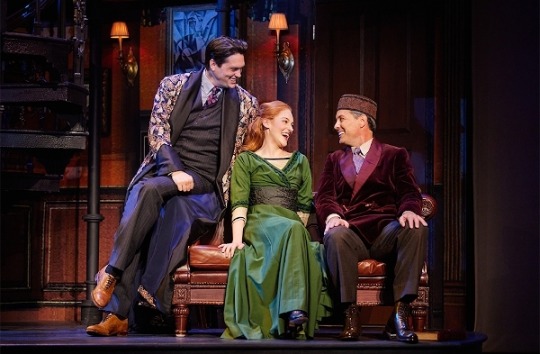
View On WordPress
#American Dream Group#Broadway at the Bass#Broadway Dallas presents Six#Christmas Pops#Cirque du Soleil#Dallas Symphony Orchestra#Eataly#Enchant#Frozen in Frisco#Grapevine Vintage Railroad#Highland Park Village#Irina Norcross#John Norcross#Klyde Warren Park#My Fair Lady#North Pole Express#Reliant Lights Your Holidays#Texas Christkindl Market#Tree Lighting Celebration#Winnetka Heights Holiday Home Tour#Моя прекрасная леди#Риэлтор в Далласе Ирина Норкросс#риэлтор Ирина Норкросс#Цирк дю Солей
0 notes
Photo
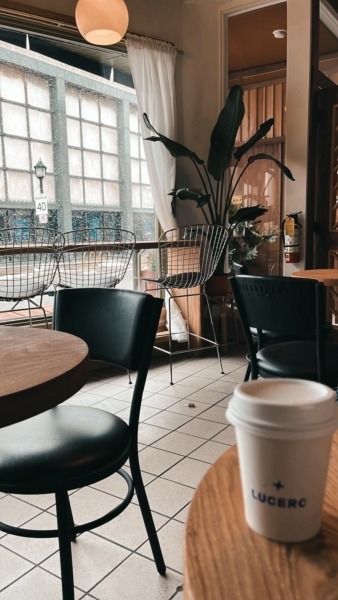

02•12•22// obsessed with this space ☕️ such a cozy little coffee shop for studying! I'm off to get ready for work and then check out the Christkindl Markt on my way to work ✨🎄
#study#study hard#studyblr#studyspo#studying#studyspiration#study motivation#aesthetic#cozy#cozy study#cozy space#cozy aesthetic#law#lawblr#coffee#coffee shop#local coffee shop#vintage#mcm#mid centruy modern
1K notes
·
View notes
Text
Time to go to the christkindle markt :3
9 notes
·
View notes
Note
Sam! I will be in Chicago this weekend and have all of Monday free.
Any reccs for things to do in Chicago or suburbs? The Christkindle Market is on the list.
I have done most of the major museums already, but also am down for food ls to try, if there are eateries on your list.
Ah, welcome! I hope you have a great time!
Recommendations for stuff to do/eat in Chicago really depend heavily on where you're going to be, physically, and what kinds of things you like to do, so it's difficult to just make blanket recommendations. Like, "the suburbs" is a MASSIVE area spanning about fifty miles, north to south, and if you're staying in Niles I don't want to tell you about stuff to do in Oak Lawn, two and a half hours away (not that I know what to do in Oak Lawn or Niles, but you see the dilemma). Although if you are in the northern suburbs, there's a festival of lights this weekend at Impact Field in Rosemont that in the past has been well worth the price of admission. And if you’re in Niles, King Spa, the Korean sauna, is a fun if sweaty way to blow a day, and their in-house restaurant is pretty great.
If you're going to be at the Christkindlemarket downtown, I would recommend Italian Village or the Berghoff for a nice meal, they're kind of Chicago standbys, but also not cheap to eat at. If you have a car or are familiar with the local public transit, you might swing past the nearest Portillo's and get an italian beef, but it's a long way to walk in the cold. I would normally recommend the Money Museum, a hidden downtown gem, but it's still not open after closing at the start of the pandemic....
If you're going to be up at the Wrigleyville Christkindlemarket, I haven't been up that way in a while and last time I was passing through a LOT had changed, but there used to be a really good thai place, Tac Quick Thai Kitchen, a few blocks north (still a bit of a hike in the cold). Outside of the stuff around the park there’s not a ton of tourist stuff to do in Wrigleyville, but if you’re a fan of cemeteries, Graceland is nearby and very historic and interesting.
I think that’s about all I got without knowing more about where you’ll be, but also at this point I’m hazy on stuff to do because we’re still semi-closed for pandemic reasons. Like, shit is open, but I don’t go to it, and especially in the winter when most of the stuff to do is indoors, I haven’t been to many places to even know if they’re still there. I’m sorry I can’t give you more to go on! I do hope you have a great time though.
48 notes
·
View notes
Text
As a continuation of my previous post here, to expand a bit more my explanation to @themousefromfantasyland about the French Père Noël, here is even more pictures of the "pre-50s" Père Noël, with a few additional comments about the visual depiction of the character. (Well technically speaking there are some Bonhomme Noël and even Bonhomme Etrennes pictures in there, but since they're all variations of the same guy...)



As you will note by looking at all these pictures (and those of the previous post), there are two main "fashions" when it comes to depicting the Père Noël. One is the "colorful" Père Noël, who wears clothes of brilliant colors - red (which led to the modern Santa Claus look), green, blue, purple... This is a visual habit that also occured in England for Father Christmas.
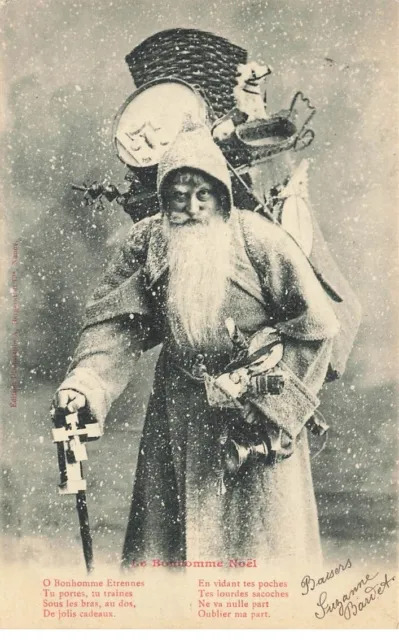


The other would be the "drab" Père Noël, depicted as a poorer and humbler person, with rather brown or dark clothes - usually a robe and a hood instead of fur-lined coats and large cloaks. This second incarnation of the Père Noël, much more unique to France, is also highlighted the disturbing connection if not gemellity between him and Père Fouettard, Father Whipper, the "evil companion" of Father Christmas in France. Père Fouettard is also depicted as an elderly man with a beard, also wearing brown or dark clothes. While sometimes Fouettard's beard is black, it can be white like Noël's, and Fouettard can also carry a wicker basket, but to take children away instead of giving toys... And you have many pictures where both Fouettard and Nël sport the same serious, judgemental, no-nonsense look (a far cry from the jolly Santa Claus).
In fact, you might notice in some of the pictures I shared that among the numerous toys Père Noël brings, there is... sometimes a whip... sometimes a bundle of branches, aka an old form of whip for children... Another one of the fleeting, confused, hesitating sides of Père Noël: sometimes, he doesn't need Père Fouettard as he is the one who gives both the toy and the whip.



I evoked the "monk-like" appearance of Père Noël, but the whole religious imagery needs to truly be explored, as Père Noël is essentialy a toned-down version of Saint Nicholas. The rich bishop clothes are gone - but there's still colorful, rich fur-lined robes with a hat on one side (colorful Père Noël), or clothes that distinctly remind of a monk's outfit (drab Père Noël). There's the ride that is very often a donkey. And the bishop staff is replaced by a walking staff or by a cane. Plus, sometimes Père Noël is shown holding a lantern to light his way through the snowy night - which evokes another archetype, the one of the semi-religious figure of the hermit. Think of the tarot card. The hermit is typically this elderly man with a beard, in simple brown robes, holding a lantern...
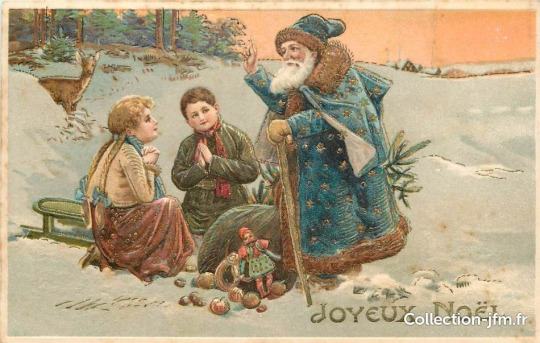
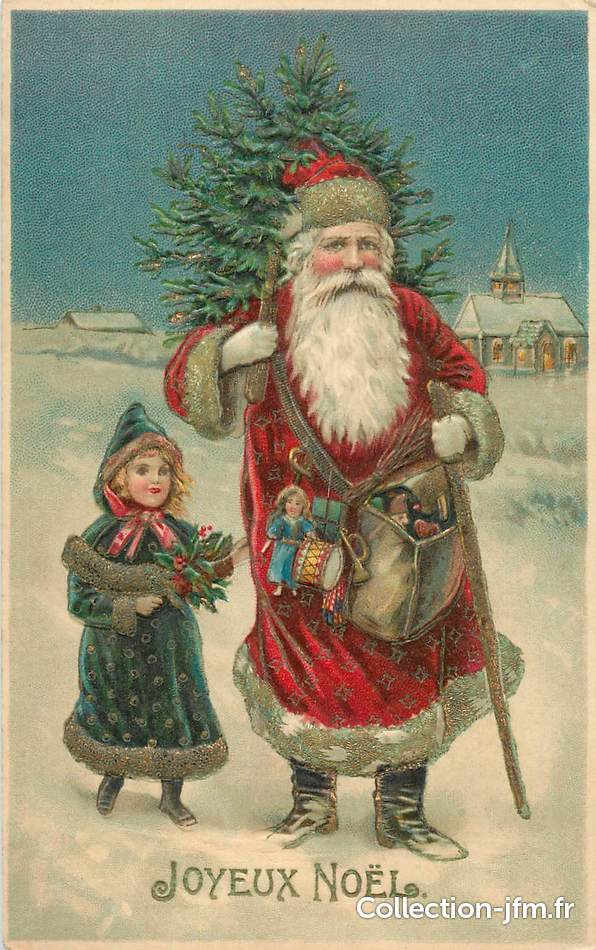
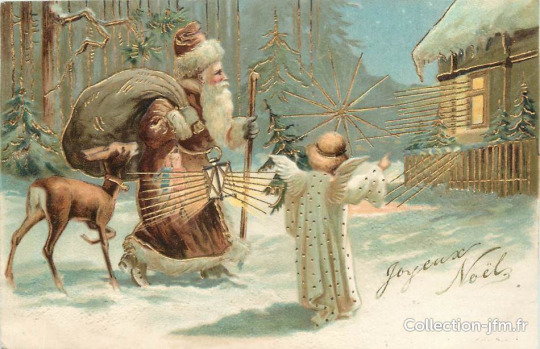
There is also in typical Père Noël depictions a certain tendency to give him robes or cloaks covered in moon or stars symbols. I don't know if there is anything to it, or if it is just an artistic fashion of the time, but I really like how these star-robes and moon-cloaks, coupled with his walking staff, hat and beard, make him look like some sort of fantasy wizard.



The fact the Christmas lore of Germanic countries reached France through the East is also manifesting itself in those imageries: you'll see leftovers of the Christkindel tradition in the shape of female angel, saint-children and other holy cherubs accompanying Père Noël.



#christmas folklore#christmas lore#père noël#christmas imagery#father christmas#french folklore#christmas art#noël#père fouettard#saint nicholas#saint nicolas#christkindel#christkindl
9 notes
·
View notes
Text
for: anyone
location: christkindl market

Why did Ben always do this? Why was he always running around a couple of weeks before the big day? At least the market was there to help, well kind of, but he was quickly finding himself distracted by a number of food stalls, not to mention wandering idly into the Christmas houses. Upon stepping into the third one, he paused to look over one of the displays, and then casually commented to the person beside him, “I feel like this would be more fun with kids.” His thoughts moved to Mira, but honestly, the 5 month old wasn’t really going to have a clue what was going on if she’d been there with him.
39 notes
·
View notes
Text
Here are some of the many names for Santa Claus.
By the way, it's Claus, not Clause. The Tim Allen movie is meant to be a pun on contractual clauses. Also I won't be counting the Halloweentown mispronunciation of Sandy Claws from Nightmare before Christmas.
Santa Claus - Derived from the Dutch for Saint Nicholas.
Saint Nicholas / Saint Nick
Kris Kringle
Christkindl - Australian / German origin of Kris Kringle.
Julnir (Yulnir) / Jolnir / Jultyr (pronounced for us English speaking ears as Yule-near.) - This is version of Santa that is either the God Odin or a light elf. The original poem "A Visit from Saint Nicholas" said he was an elf and he's an elf when depicted in Marvel comics. Not the ridiculously short elves that American folklore seems used to but relatively human sized.
He is from Nordic countries, Asatru / Heathen and Wiccan traditions. The Marvel animated movie Frost Fright confirms that Jolnir exists in Marvel comics. Come to think of it, a Ghost Rider one shot confirms that Krampus exists in Marvel comics.
Father Christmas - Popular UK name for Santa.
And finally...
Befana - I love Befana. She's actually from Italian folklore and kids in Italy believe in her today. She was a witch friend of the Three Wise Men (who were actually wizards in original traditional lore. That's what Magi means). She couldn't accompany them to see the Christ child because she was too busy cleaning. Now on the eve of Epiphany (January 5th / 6th) she flies on her backward broom (bristles facing front) and goes down the chimney. She delivers presents to good children, and leaves coal in the stockings of bad children.
She performs exactly the same way Santa does and I think she's an adorable character. I wish she'd catch on here in the US. Children leave milk out for her. Apparently she loves milk. (A witch after my own heart!)
And since she does her gift giving on Epiphany it's easy to let your kids believe in Santa AND Belfana (just divide up the gifts so they get half at Christmas and half at Epiphany. To a child's mind it means double the gifts).
Belfana is the only female equivalent of Santa and she is my favorite.
4 notes
·
View notes
Text
conspiracy theory. jesus didnt die on the cross. faked it. hid away in the north pole so no one would find him. grew old but couldnt die on account of the whole god thing. thats right folks, kris kringle is the christkindl
3 notes
·
View notes
